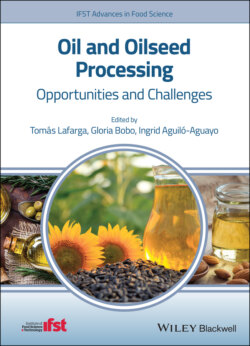Читать книгу Oil and Oilseed Processing - Ingrid Aguilo-Aguayo - Страница 32
2.2 Oilseeds 2.2.1 Description of Oilseeds
ОглавлениеOilseeds have three basic parts, the seed coat, the endosperm, and the cotyledon. The seed coat is marked with a seed scar and its main function is protecting the embryo from infections. The cotyledons work as food reserve structures. For this reason, in the oilseeds cotyledons there are discrete cellular organelles called proteins and lipid bodies (aleurone grains and spherosomes and oleosomes, respectively) throughout the germ cells (Rosenthal et al. 1996). The lipid particles consist of a core of triacylglycerols and or steryl esters. A phospholipid monolayer surrounds the core with only a small quantity of proteins (oleosins) that help to stabilize the spherosomes of oilseeds during desiccation in the seed maturation (Zweytick et al. 2000).
During the last decades the consumption of animal fats has been decreasing, and, on the other hand, the consumption of vegetable oils has increased. The most important vegetable oils can be classified as four major oils (palm, soybean, rapeseed, and sunflower), two lauric oils (coconut and palm kernel) and the remaining oils (cottonseed, groundnut, and olive). Another kind of classification is distinguishing between oils and fats obtained from trees as coconut, palm, and olive, or those from annual seeds or beans as soybean, rapeseed, groundnuts, and cottonseeds. Some of them, for example, cottonseed and peanuts (groundnut seeds), have woody hulls and shells, which have to be removed before processing (Gunstone 2011).
Edible oils and fats are essential nutrients. Vegetable oils usually have high concentration of polyunsaturated fatty acids (PUFAs). There are some exceptions as coconut (copra), palm, and palm kernel oils which are mainly saturated. Olive and canola oils have less PUFAs and more monounsaturated fatty acids (MUFAs) (Dupont 2003).
The nutritional and also the industrial value of a vegetable oil depend on its fatty acid composition. There is a particular importance in PUFAs because of animal cells cannot synthesize linoleic acid (C18:2 n‐6) and α‐linolenic acid (C18:3 n‐3), which have essential metabolic functions. For this reason they are considered as dietary essential fatty acids (Balbino 2017). In general, oils and fats supply calories and help with the absorption of the fat‐soluble vitamins A, D, E, and K. They also work as functional ingredient because help to improve the sensory characteristics of food products (Salunkhe et al. 1992). Also the proportions of fatty acids determine the physical form of the fat, which mean that a higher amount of PUFAs and MUFAs content in oil the more liquid it will be at room temperature. When the content of saturated fatty acids is high they are usually more solid at room temperature; sometimes they are referred as “solid fats” (e.g. coconut).
Linoleic acid (C18:2 n‐6) and α‐linolenic acid (C18:3 n‐3) are called essential because the human body can produce two whole families of polyunsaturated fatty acids from them as a precursors. For example, from n‐6 family (linoleic acid) it can obtain arachidonic acid (ARA) (20:4 n‐6) and docosapentaenoic acid (22:5 n‐6), among others. In the case of n‐3 family (α‐linolenic acid) it can be produced eicosapentaenoic acid (20: 5n‐3) and docosahexaenoic acid (22: 6 n‐3, DHA). Some of these molecules have great importance in human metabolisms. For example ARA is abundant in the brain, muscles, and liver. It has been explained that it is not an essential fatty acid, however if there is a deficiency in linoleic acid, it becomes essential (Smith et al. 2011). This acid is involved in muscle growth and brain. It is present in the brain in similar quantities as DHA both of them are involved in the neurological health. Furthermore, there are studies like Birch et al. (2000) about supplementation of infant formula with DHA + ARA where an increase on the Mental Development Index (MDI) was observed. Also at cognitive and motor subscales of the MDI there was a significant developmental age advantage for supplementation with DHA or DHA + ARA (Birch et al. 2000).
